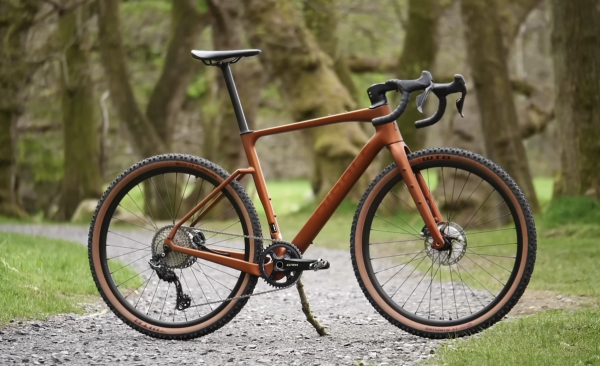One bike to rule them all: Can a gravel bike double up as a road bike?
If you only want to own a single bike, a gravel steed could be the most versatile option
Tom Hallam-Gravells
Online Production Editor
Gravel bikes have rocketed in popularity over the last 10 years, driven by the burgeoning gravel scene which started in the US but has slowly crept across the world. Considered the latest fad at first, they started as a way to enjoy off-road adventures and escape the shackles of the road, with no concerns about average speed or aerodynamics.
As the discipline has developed, that has changed, and the number and types of bikes has diversified, opening up a whole range of opportunities. Gravel bikes are now so versatile that they offer high levels of performance on-road as well as off-road. That’s why many cyclists choose to only own a gravel bike, which they use for both their on-road and off-road needs.
This one-bike gravel solution is becoming an increasingly popular route, but there is still a level of compromise, so can a gravel bike really double up as a road bike? Here’s everything you need to know if you’re planning on only using a gravel bike in the future.
Read more:
Why only own one bike?
Nowadays, there are a bewildering number of specialist bikes available. In the realms of drop bars, there is road, cyclo-cross and gravel, but each of these off-shoot into different specialisms. This can be a problem as, let’s be honest, modern bikes have a big impact on bank balances. For many cyclists, owning more than one bike simply isn’t an option. The problem is, if your sole bike is designed for a specific purpose, like an aero road bike, there’s a limit to the types of riding you can do.
That’s fine if you only want to ride on the road, but what if you’ve caught the adventure bug? In that case, you’ll need something that can conquer the rough stuff and glide over smooth tarmac. That requires versatility and this is where gravel bikes enter the equation.
While gravel bikes are primarily designed for off-road riding, they share many characteristics with road bikes and are capable of adapting to tarmac.
The gravel spectrum
Before we look at the design of gravel bikes, it’s important to acknowledge that the term ‘gravel’ encompasses a wide range of riding styles. On one side there are bikes that are close cousins of performance road bikes. These are designed for speed and racing.
At the other end of the spectrum, there are those purely built for off-road adventures. They often have monster tyre clearance, more mounts than you can count, slack geometry and, as is becoming more common, suspension forks. These are the off-road equivalent of endurance road bikes, favouring practicality and comfort for those who aren’t too worried about staying aero and maintaining a high average speed.

© Canyon
The Canyon Grail is on the more race-focused side of the scale
Across this full spectrum, designs will vary greatly to meet certain demands of off-road riding. These will in turn affect how a bike performs on the road. Here’s everything you need to consider when buying a gravel bike which will double up as a road bike.
Geometry
Similarly to road bikes, the geometry of gravel bikes can vary greatly. Some have aggressive geometries, helping a rider to get into an aerodynamic position, which ultimately equals extra speed. These frames are very similar to those of performance road bikes, with a few small changes, such as larger tyre clearance, to give them the necessary off-road capability.
Then there are adventure-focused bikes with slacker geometries. The aim of these bikes is to help the rider get into a comfortable rather than an aero position. This is important for long or multi-day adventures when, usually, having fun and staying comfortable and controlled trumps going fast.
The same geometry principles from road bikes apply to gravel bikes too, and the main things to look out for are reach and stack. Aerodynamic bikes usually have longer reaches but shorter stack heights. This gets a rider into a stretched but lowdown position. A shorter reach and higher stack height will lead to a more relaxed geometry.
Beyond the similarities, there are some geometry differences between road and gravel bikes. For a start, gravel bikes tend to have slacker head angles to improve control off-road, but it can make the bike feel sluggish on tarmac. The same can be said for longer chainstays, a common feature added to boost tyre clearance, which usually makes the bike less nimble. Some gravel bikes go without longer chainstays and slacker angles, but that will usually be at the expense of off-road performance, so think carefully about what you need.
Tyre clearance

© GCN
Tyre clearance is one of the biggest limiting factors for bikes
Aesthetically, gravel and road bikes are very similar. The most striking difference is the tyre clearance, and subsequent tyre width, which also makes the largest difference in performance too.
Tyre clearance indicates the maximum tyre size a bike can accommodate. For more rugged gravel riding, a minimum of 40mm is required. Many bikes far exceed this number and some gravel bikes can accommodate 650b wheels as well as the traditional 700c, which usually boosts the tyre clearance a little too.
The amount of tyre clearance you need depends on the type of riding you’ll mainly be doing. For speed, less will be required, but for adventure, the more the better. Even if you’re more interested in speed, it’s still worth considering more tyre clearance than you think you’ll need, just in case you catch the adventure bug and have the urge for more extreme gravel in the future.
While there are limitations on the maximum tyre size, there’s no such problem when downsizing. Virtually any gravel bike with 700c wheels can be adapted to the road by simply changing to narrower road tyres. The main and most obvious benefit of doing this is the added speed. As they’re narrower and less knobbly, road tyres have less rolling resistance. For a performance gravel bike, simply swapping to a pair of road tyres can completely revamp the on-road performance.
Of course, road tyres aren’t a necessity for riding on tarmac and it all depends on your preference.
1x or 2x groupsets?
After tyre clearance, the groupset is the most important choice. 2x set-ups still dominate on the road but 1x has more or less taken over on gravel.
There are advantages to both. 1x systems are simpler as you don’t have a front derailleur to worry about. There’s also less chance of dropping a chain, which can be a big problem in gravel riding when you’re clattering over bumpy terrain. Topping off the list of benefits, they usually have a much easier spinning gear for steep ramps than 2x set-ups.
On the flip side, 2x set-ups have a wider range of gears, meaning there’s less of a jump between the cogs. This is becoming less of a problem as gravel technology develops and brands expand the capabilities of their 1x offerings, though. Campagnolo’s Ekar groupset, for example, is 13-speed which greatly reduces the jump between gears.

© GCN
Gravel groupsets often have very easy spinning gears for riding uphill
Most gravel bikes are now specced with 1x and, unless the majority of your riding is on tarmac, we’d stick to a single chainring up front. It’s the better option for gravel riding and there isn’t a major performance penalty on the road - testament to this, most SRAM-sponsored WorldTour teams frequently used 1x throughout the 2023 season.
These 1x groupsets will usually be gravel-specific too - SRAM is the only major groupset manufacturer which offers a 1x road groupset and these components can sometimes be used on gravel bikes. Most gravel-specific groupsets will have certain features designed for off-road riding, like clutch mechanisms which keep the chain tight, no matter the terrain. These are featured on Shimano GRX groupsets.
- Read more: Shimano GRX RX820 - first look
Disc brakes rule
The rim brake versus disc brake argument is still thriving in some corners of the road world. That argument has long since died in the world of gravel, where disc brakes rule - more specifically, hydraulic disc brakes.
While some bikes are still specced with cable-actuated discs, we’d always recommend choosing a bike with the hydraulic equivalent. These offer more confidence-inspiring and refined performance, which is more important when riding off-road.
This may be an obstacle for any rim brake aficionados who have remained loyal, but disc brakes are the only option for a one-bike solution.
Should you only own a gravel bike?
Ultimately, it depends on your needs. If you don’t want to spend the money on more than one bike, then a gravel bike is a good compromise - but the word ‘compromise’ is key.
While it will excel on certain off-road terrain, it’s never going to reach the capabilities of a mountain bike, while on the road it will always lack that pure performance edge. The performance loss may not be big on paper but as Si Richardson points out, it is very noticeable when out riding.
“I don’t think a gravel bike is ever going to be able to do what a mountain bike is able to do, they’re just more limited. When it comes to the road side of things, they’re not limited in the same way because a gravel bike can go the same places a road bike can, but they just feel so different,” he explains.
“We’ve seen time and time again that you can measure the difference in speed at the same effort between a gravel bike and a road bike and, while the difference might seem small on paper, in my experience the human body is very good at being able to perceive these small differences out on the road. So even a fraction of a second can translate into an increased feeling of exhilaration that you get when riding an out and out road bike.”

© GCN
A gravel bike will feel different to a road bike when riding on tarmac
Of course, Si is a former pro with a penchant for speed, so his perception will be different to someone who is less speed focussed and, ultimately, a high proportion of cyclists simply want to enjoy rides. If speed isn’t a part of that enjoyment equation for you, then a gravel bike may well be the best option.
Otherwise, we don’t expect to see roads being swarmed with gravel bikes anytime soon.











.jpg?w=600&auto=format)



